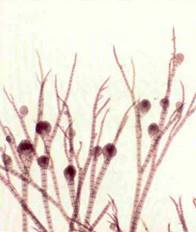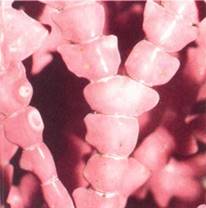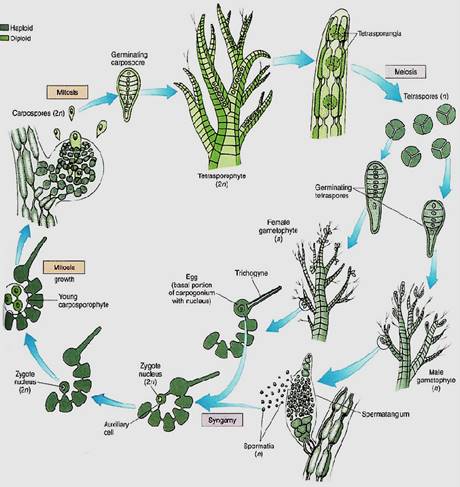


 النبات
النبات
 الحيوان
الحيوان
 الأحياء المجهرية
الأحياء المجهرية
 علم الأمراض
علم الأمراض
 التقانة الإحيائية
التقانة الإحيائية
 التقنية الحيوية المكروبية
التقنية الحيوية المكروبية
 التقنية الحياتية النانوية
التقنية الحياتية النانوية
 علم الأجنة
علم الأجنة
 الأحياء الجزيئي
الأحياء الجزيئي
 علم وظائف الأعضاء
علم وظائف الأعضاء
 الغدد
الغدد
 المضادات الحيوية
المضادات الحيوية|
Read More
Date: 17-11-2016
Date: 19-11-2016
Date: 19-11-2016
|
Division Rhodophyta: Red Algae
The red algae constitute a large group (about 400 genera and 3900 species) of especially distinct and fascinating algae (Figs. 1, and 2, and Table ). Numerous structural, biochemical, and reproductive features set them off from the other algae as well as from true plants. One of the most important biochemical distinctions of red algae is that, like cyanobacteria, they contain phycobilin accessory pigments that are aggregated into phycobilisomes . Their red color is due to the presence of phycoerythrin; however, they are often purple, brown, or black owing to the additional presence of phycocyanin, just as in cyanobacteria. Carotenoid accessory pigments are also present, as is chlorophyll a. The actual quantities of each type of pigment vary with depth. Those algae that grow in bright surface waters have an array of pigments suitable for relatively intense light, whereas algae in deeper waters have a different complex of pigments that is better suited both to the dimmer light and to the altered spectrum present as a result of the water's differential color absorption.

FIGURE 1:Many red algae have highly branched, filamentous bodies. Polysiphonia (X 20). (Runk/Schoenberger from Grant Heilman).
Excess photosynthate is stored as floridean starch, a branched polymer of glucose somewhat similar to glycogen; it occurs as granules in the cytoplasm, never in the chloroplast. Other reserves occur which contain unusual sugars such as floridoside and isofloridoside, indicating that the carbohydrate metabolism of red algae has characteristic features not shared by plants.
In addition to a thin layer of cellulose, the walls of red algae contain a thick layer of slimy mucilages composed of compounds called sulfated galactans. These are important commercially as thickening, suspending, or stabilizing agents in puddings, ice creams, cheeses, and salad dressings. The culture medium agar is also extracted from them. The complete wall—cellulose layer plus mucilage—is quite thick, often as thick as the protoplast is wide. Almost all red algae are multicellular, so a large fraction of the individual's volume consists of this apoplastic space. As a result, all cells, even the most internal ones, may have relatively direct contact with the surrounding water. In the largest family of rhodophytes, the Corallinaceae or coralline red algae, such large amounts of calcium carbonate are deposited in the walls that they become rocklike (Fig. 2). It was not until 1837 that they were recognized as algae rather than corals.

FIGURE 2 :Coralline red algae have walls so heavily impregnated with calcium carbonate that the body is hard and brittle. (Peter Arnold/Sea Studios, Inc.).

Walls of red algae lack plasmodesmata of the type that occurs in plants, but they do have distinctive pit connections . During cell division, the new wall is formed as a ring that grows inward from the original cell wall; the growth of the septum stops before it is complete, leaving a hole in the center. Vesicles then deposit a material that precipitates, forming a lens-shaped plug. Whether these are a means of intercellular transport or communication is not known, but when two separate filaments of cells come into contact, a "secondary pit connection" can form between them.
Red algae are usually multicellular; only a few unicellular species (Porphyridium, Rhodospora) have ever been discovered. Most red algae tend to be rather conspicuous, often Beautiful individuals and arc filamentous, membranous, or foliaceous; true parenchymatous bodies are reported to occur in only a few algae, such as Bangia and Porphyra. Typically red algae are smaller and less complex than brown algae. Like brown algae, the ancestors of the red algae must have diverged from the ancestors of green algae very early, certainly before multicellularity had evolved.
Despite the rather large size that the bodies of red algae can attain, little differentiation or specialization occurs among the cells. The greatest differentiation typically involves only cell size and pigmentation. Outer cells are smaller and more heavily pigmented; inner cells are larger and have fewer, smaller chloroplasts.
Most species grow attached by rhizoids to rocks, shells, algae, or sea grasses. Numerous red algae (more than 40 genera) are parasitic, usually on other red algae. The basal cell of these species penetrate into the host, forming secondary pit connections with host cells.
The life cycles of most red algae are poorly known, but the few that have been studied well are all extremely complex, almost all involving at least one multicellular stage but none having any motile cells; flagella and centrioles do not occur in any stage of any species. Many variations occur and there is no "typical" red alga life cycle. Figure 3 is a generalized life cycle. Gametophytes bear gametangia that produce nonmotile sperm cells called spermatia and egg-like cells called carpogonia. The carpogonia are large cells with a long tubular extension that basically acts as a receptor for drifting spermatia. When a spermatium contacts the extension, plasmogamy occurs and the nucleus migrates to to the carpogonium base, where karyogamy occurs. In any other group, this cell would be a zygote and would either grow or produce spores. But in many red algae, the fertilized carpogonium puts out another long filament that carries the diploid nucleus out of the carpogonium and deposits it into a totally different cell, an auxiliary cell, where mitosis begins and produces a mass of cells. This mass is a new generation, the carposporophyte, and it produces diploid carpospores by mitosis. The carposporophyte is a totally distinct generation from any other mentioned for any other algae or plants. Carpospores are released, float away and settle, and then germinate and grow into diploid plants called tetrasporophytes, equivalent to a regular sporophyte; these have sporangia in which the cells undergo meiosis, producing haploid tetraspores that grow into gametophytes.

FIGURE 3: Life cycle of a red alga; details are given in text. Note especially the lack of swimming cells and the presence of three generations, one haploid and two diploid.



|
|
|
|
علامات بسيطة في جسدك قد تنذر بمرض "قاتل"
|
|
|
|
|
|
|
أول صور ثلاثية الأبعاد للغدة الزعترية البشرية
|
|
|
|
|
|
|
مكتبة أمّ البنين النسويّة تصدر العدد 212 من مجلّة رياض الزهراء (عليها السلام)
|
|
|